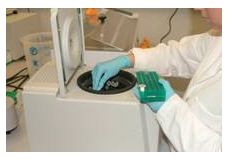Archival Notice
This is an archive page that is no longer being updated. It may contain outdated information and links may no longer function as originally intended.
Home | Glossary | Resources | Help | Contact Us | Course Map
Many techniques in forensic biology and DNA analysis call for centrifugation. Analysts should understand proper use of specific centrifuges in the laboratory, as they may be designated for specific uses and/or be set to specific speeds for certain steps in a procedure. Given the relatively small volumes handled, the maximum throughput of a centrifuge for efficient use is generally not calculated, but rather analysts depend upon empirically determined and validated or manufacturer recommended volumes and speeds.
The centrifugal force created by spinning separates mixtures based on particle size and the difference in density between liquid and solid phases in the tube. Equations considering many variables such as particle size, solution density, and angular velocity may be used to determine a rate of centrifugation. Commercial products generally indicate appropriate settings in a bulletin or user's manual. This is particularly important when dealing with smaller and thin-walled tubes as well as spin baskets or other inserts with filters, as excessive force may cause them to fail. Overall, centrifuges play an important role in the forensic DNA laboratory in procedures such as extraction and preparation for quantitation and analysis. It should be noted that relative centrifugal force (RCF) and/or rotations per minute (RPM) can be verified by outside vendors.
Additional Online Courses
- What Every First Responding Officer Should Know About DNA Evidence
- Collecting DNA Evidence at Property Crime Scenes
- DNA – A Prosecutor’s Practice Notebook
- Crime Scene and DNA Basics
- Laboratory Safety Programs
- DNA Amplification
- Population Genetics and Statistics
- Non-STR DNA Markers: SNPs, Y-STRs, LCN and mtDNA
- Firearms Examiner Training
- Forensic DNA Education for Law Enforcement Decisionmakers
- What Every Investigator and Evidence Technician Should Know About DNA Evidence
- Principles of Forensic DNA for Officers of the Court
- Law 101: Legal Guide for the Forensic Expert
- Laboratory Orientation and Testing of Body Fluids and Tissues
- DNA Extraction and Quantitation
- STR Data Analysis and Interpretation
- Communication Skills, Report Writing, and Courtroom Testimony
- Español for Law Enforcement
- Amplified DNA Product Separation for Forensic Analysts


